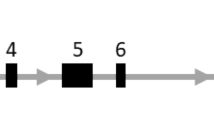Abstract
Specific apolipoprotein E alleles have been associated in the last few years with several diseases using appropriate controls. However, these control groups are rarely representative of the general population since they correspond either to aged or healthy control groups (and thus depleted of pathological alleles). For this reason it is difficult at present to compare population allelic frequencies in different countries. In order to provide this essential basic data representative of the general population, in this work we have determined the distribution of apolipoprotein E alleles in 226 individuals from the population of Catalonia (Spain) sampled with the main purpose of paternity testing. The allelic frequencies are: ε2 = 0.064, ε3 = 0.810 and ε4 = 0.126, predicting a lower incidence of Alzheimer disease and possibly also of other pathologies where this allele is a risk factor.
Similar content being viewed by others
References
Davignon J, Bouthilier D, Nestruck AC, Sing CF. Apolipoprotein E polymorphism and atherosclerosis: Insight from a study in octagenarians. Trans Am Clin Climatol Assoc 1987; 99: 100–110.
Fiol-Castaño C, Pintó X, Santamaria P. Predisposition to hereditary atherosclerosis and genetic polymorphism of ApoE. Abstract 8th International Symposium on Atherosclerosis. Rome, 9–13 October, 1988.
Hallman DM, Boerwinkle E, Saha N, Sandholzer C, Menzel HJ, Csázár A, Utermann G. The apolipoprotein E polymorphism: A comparison of allel frequencies and effects in nine populations. Am J Hum Genet 1991; 49: 338–349.
Gerdes LU, Klausen IC, Sihm I, Faergeman O. Apolipoprotein E polymorphism in a Danish population compared to findings in 45 other study populations around the world. Genet Epidemiol 1992; 9: 155–167.
Wenham PR, Price WH, Blundell G. Apolipoprotein E genotyping by one-stage PCR. Lancet 1991; 337: 1158–1159.
Strittmatter WJ, Saunders AM, Schmechel D, Pericak-Vance M, Enghild J, Salvesen GS, Roses AD. Apolipoprotein E: High-avidity binding to β-amyloid and increased frequency of type 4 allele in late-onset familial Alzheimer disease. Proc Natl Acad Sci USA 1993; 90: 1977–1981.
Saunders AM, Strittmatter WJ, Schmechel D, St George-Hyslop PH, Pericak-Vance MA, Joo SH, Rosi BL, Gusella JF, Crapper-MacLachlan DR, Alberts MJ, Hulette C, Crain B, Goldgaber D, Roses AD. Association of apolipoprotein E allele ɛ4 with late-onset familial and sporadic Alzheimer's disease. Neurology 1993; 43: 1467–1472.
Poirier J, Davignon J, Bouthillier D, Kogan S, Bertrand P, Gauthier S. Apolipoprotein E polymorphism and Alzheimer's disease. Lancet 1993; 342: 697–699.
Van Duijn CM, Knijff P, Cruts M, Wehnert A, Havekes LM, Hofman A, Van Broeckhoven C. Apolipoprotein E4 allele in a population-based study of early-onset Alzheimer's disease. Nat Genet 1994; 7: 74–78.
Adroer R, Santacruz P, Blesa R, López-Pousa S, Ascaso C, Oliva R. Apolipoprotein E4 allele frequency in Spanish Alzheimer and control cases. Neurosci Lett 1995; 189: 182–186.
Blesa R, Adroer R, Santacruz P, Ascaso C, Tolosa E, Oliva R. High apolipoprotein E ɛ4 allele frequency in age related memory decline. Ann Neurol 1996; 39: 548–551.
Snowden C, Houlston RS, Arif MH, Laker MF, Humphries SE, Alberti KGMM. Disparity between apolipoprotein E phenotypes and genotypes (as determined by polymerase chain reaction and oligonucleotide probes) in patients with non-insulin-dependent diabetes mellitus. Clin Chim Acta 1991; 196: 49–58.
Hansen PS, Gerdes LU, Klausen IC, Gregersen N, Faergeman. Genotyping compared with protein phenotyping of the common apolipoprotein E polymorphism. Clin Chim Acta 1994; 224: 131–137.
James RW, Ruiz J, Blanché H, Pometta D, Passa Ph, Froguel Ph. Phenotyping is an accurate means of analysing the principal apolipoprotein isoforms. Clin Chim Acta 1994; 225: 77–82.
Davignon J, Gregg RE, Sing CF. Apolipoprotein E polymorphism and atherosclerosis. Atherosclerosis 1988; 8: 1–21.
Dallogeville J, Lussier-Cacan S, Davignon J. Modulation of plasma trigliceride levels by apoE phenotype: A meta-analysis. J Lipid Res 1992; 33: 447–454.
de Knijff P, Kaptein A, Boomsma D, Princen HM, Frants RR, Havekes LM. Apolipoprotein E affects plasma level of lipoprotein. Atherosclerosis 1991; 90: 169–174.
Walden CC, Hegele RA: Apolipoprotein E in hyperlipidemia. Ann Intern Med 1994; 120: 1026–1036.
Dickinson-Gibbons J. Non-parametric methods for quantitative analysis. New York: Holt, Rinehart & Winston, 1976.
Guo CW, Thompson EA. Performing the exact test of Hardy-Weinberg proportion for multiple alleles. Biometrics 1992; 48: 361–372.
Corbo RM, Scacchi R, Mureddu L, Mulas G, Alfano G. Apolipoprotein E polymorphism in Italy investigated in native plasma by a simple polyacrylamide gel isoelectric focusing technique: Comparison with frequency data of other European populations. Ann Hum Genet 1995; 59: 197–209.
Tiret L, Knijff P, Menzel HJ, Ehnholm C, Nicaud V, Havekes LM. ApoE polymorphism and predisposition to coronary heart disease in youths of different European populations. The EARS Study (European Atherosclerosis Research Study). Arterioscler Thromb 1994; 14: 1617–1624.
Muros M, Rodríguez-Ferrer C. Apolipoprotein E polymorphism influence on lipids, apolipoproteins and Lp(a) in a Spanish population underexpressing apo E4. Atherosclerosis 1996; 121: 13–21.
Uemura K, Pisa Z. Trends in cardiovascular disease mortality in industrialized countries since 1950. World Health Statist Quart 1988; 41: 155–177.
Plans P, Pardell H, Salleras L. Epidemiology of cardiovascular disease risk factors in Catalonia (Spain). Eur J Epidemiol 1993; 9: 381–389.
Goldstein MR. Mediterranean diet and coronary heart disease. Lancet 1994; 344: 276.
Aguilera F, Lupiañez L, Magañe D, Planells E, Mataix FJ, Llopis J. Lipid status in a population of Spanish schoolchildren. Eur J Epidemiol 1996; 12: 135–140.
Author information
Authors and Affiliations
Rights and permissions
About this article
Cite this article
Gené, M., Moreno, P., Ezquerra, M. et al. Low apolipoprotein E ε4 allele frequency in the population of Catalonia (spain) determined by Pcr-Rflp and Laser fluorescent sequencer. Eur J Epidemiol 13, 841–843 (1997). https://doi.org/10.1023/A:1007389303525
Issue Date:
DOI: https://doi.org/10.1023/A:1007389303525



